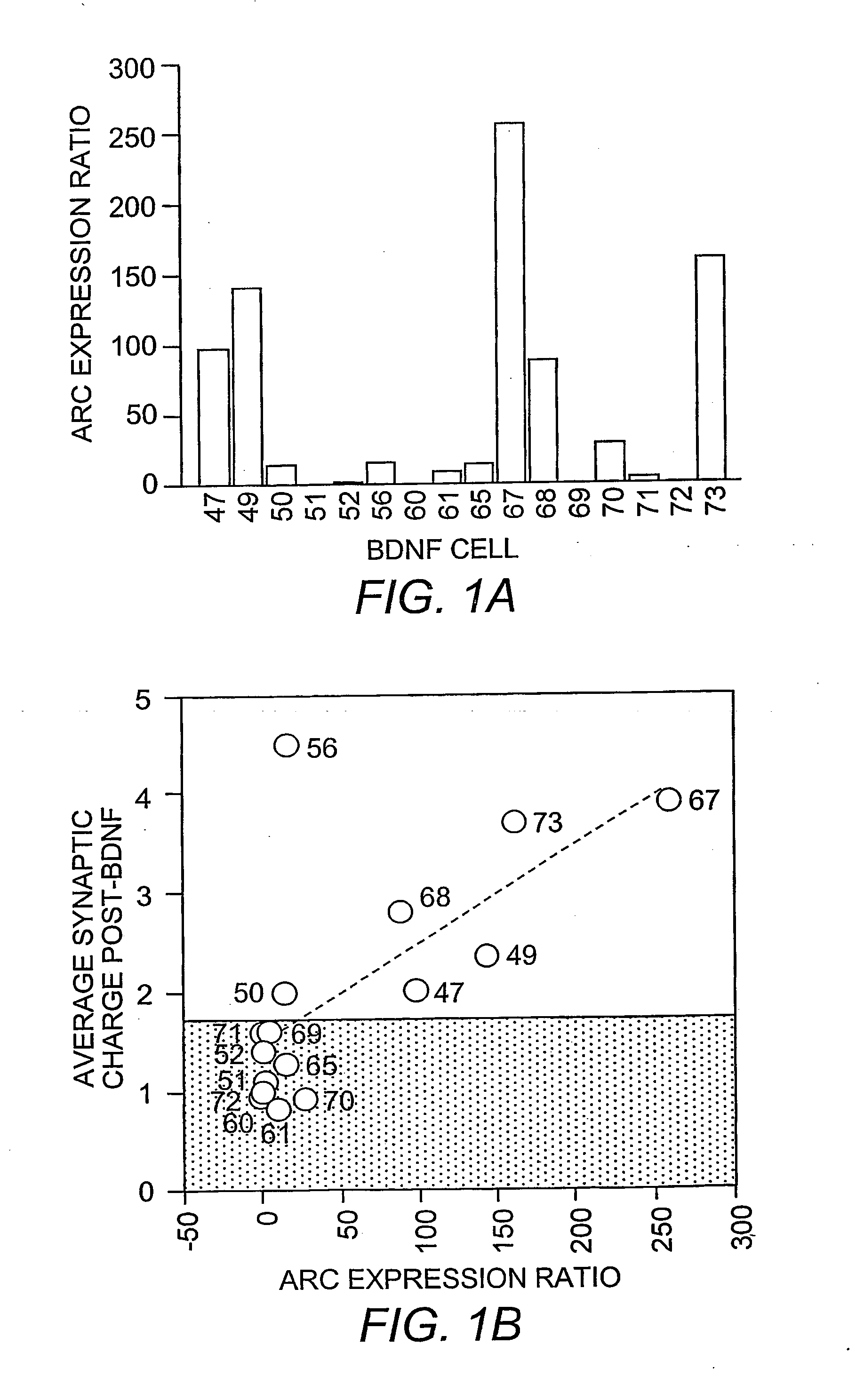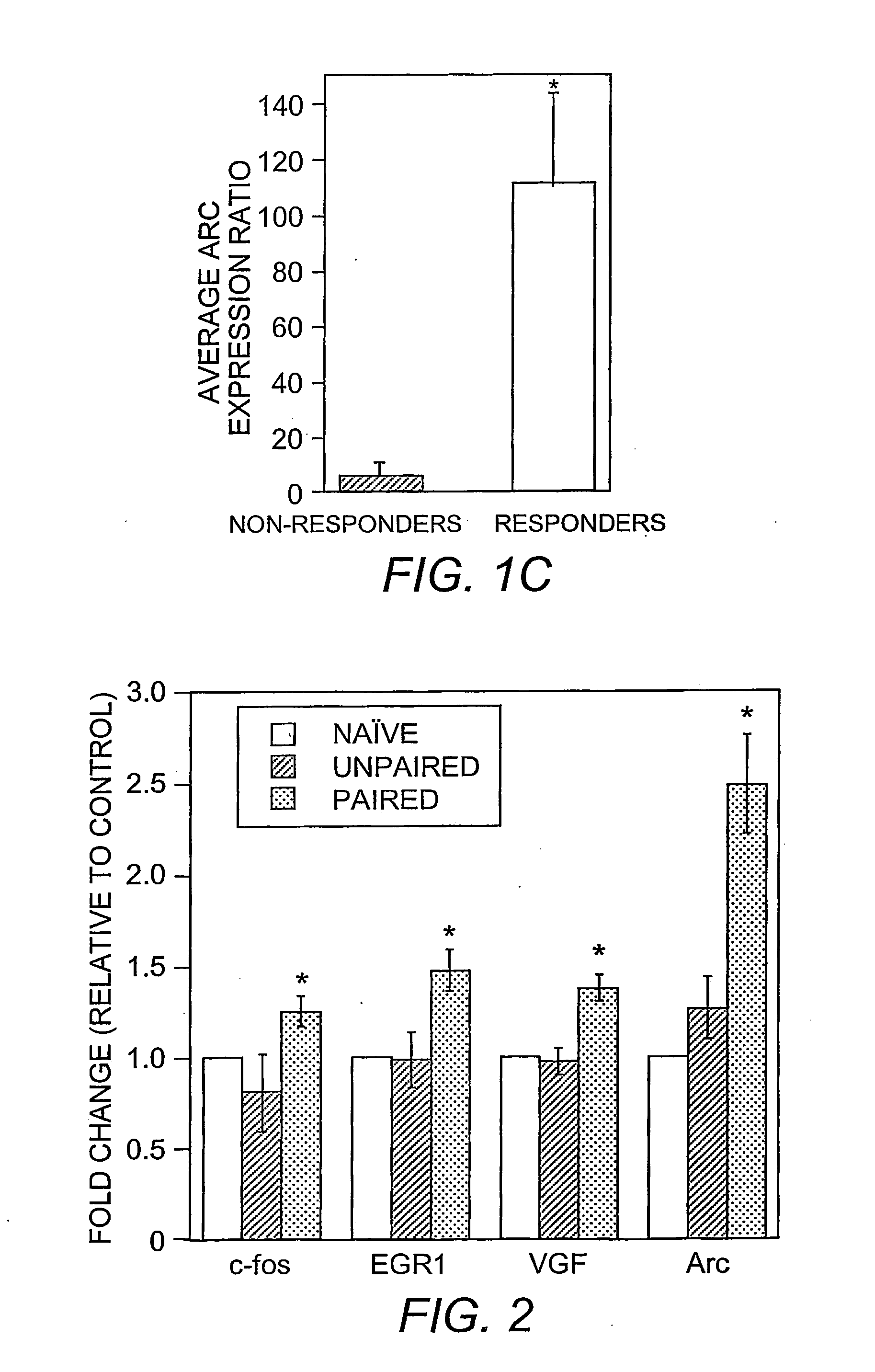Method for increasing synaptic growth or plasticity
a synaptic growth and plasticity technology, applied in the field can solve the problems of limited molecular genetics of bdnf-induced plasticity, and studies that did not address the molecular mechanisms associated with distinctive single cell synaptic responses to bdnf, so as to increase the effect of increasing synaptic growth or plasticity
- Summary
- Abstract
- Description
- Claims
- Application Information
AI Technical Summary
Benefits of technology
Problems solved by technology
Method used
Image
Examples
example 1
Cell Culture Preparation
[0093] Time-mated pregnant rats were sacrificed by CO2 asphyxiation in accordance with institutional guidelines for care and use of animals. Fetuses were removed by caesarean section and transferred to a sterile petri dish with phosphate-buffered saline. Fetal hippocampi were dissected from surrounding brain tissue and meninges were completely removed. Low-density cultures of dissociated embryonic day 18 rat hippocampi (Sprague Dawley from Hilltop Laboratories, Scottsdale, Pa.) were prepared using standard methods (Thakker-Varia et al. (2001) supra). Briefly, pooled tissue from each litter was mechanically dissociated in nutrient medium containing 7.5% fetal bovine serum and plated on poly-D-lysine-coated culture dishes at 350,000 cells / dish. Cultures were maintained in serum-free medium (Thakker-Varia et al., 2001) for 10-14 days and contained pure neurons.
example 2
Electrophysiological Recordings
[0094] Whole-cell patch clamp recordings were performed after 10-14 days in culture. Currents were recorded with an Axoclamp 200 amplifier, digitized at 2.5 kHz with an INDEC IDA 15125 interface, filtered at 5 kHz and stored. Recording parameters and stimulus protocols were controlled by custom software written with Borland C++ that utilizes device driver libraries supplied by INDEC. Data analysis programs were written with Microsoft Visual Basic. The. external bath solution for voltage clamp recordings was (in mM) 1.67 CaCl2, 1 MgCl2, 5.36 KCl, 137 NaCl, 17 glucose, 10 HEPES and 20 sucrose (neuron recording solution, NRS). The pipette solution contained (in mM) 105 Cs-methanesulfonate, 17.5 CsCl, 10 HEPES, 0.2 EGTA, 8 NaCl, 2 Mg-ATP, 2 Na-ATP, 0.3 Na-GTP, 20 phosphocreatinine, and 50 U / ml creatinine phosphokinase. All recordings were made at room temperature. The typical range of pipette resistance was 3-5 MΩ. Cell capacitance was 10-20 pF and access...
example 3
[0095] Data were analyzed by integrating the synaptic currents for each sweep (synaptic charge). The charge measurements for all sweeps in a 1 min period were averaged (binned). Baseline is considered the average synaptic charge during the 2 min period (−2 to 0 min) in NRS immediately prior to BDNF or VGF application. Fold increases were then determined by dividing the synaptic charge during BDNF or VGF exposure by the baseline. Recordings were rejected if either the 0-5 min binned time period or 5-10 min binned time period after switching during BDNF or VGF exposure was 2×SEM below baseline, indicating “run down”.
PUM
| Property | Measurement | Unit |
|---|---|---|
| Digital information | aaaaa | aaaaa |
| Plasticity | aaaaa | aaaaa |
Abstract
Description
Claims
Application Information
 Login to View More
Login to View More - R&D
- Intellectual Property
- Life Sciences
- Materials
- Tech Scout
- Unparalleled Data Quality
- Higher Quality Content
- 60% Fewer Hallucinations
Browse by: Latest US Patents, China's latest patents, Technical Efficacy Thesaurus, Application Domain, Technology Topic, Popular Technical Reports.
© 2025 PatSnap. All rights reserved.Legal|Privacy policy|Modern Slavery Act Transparency Statement|Sitemap|About US| Contact US: help@patsnap.com


